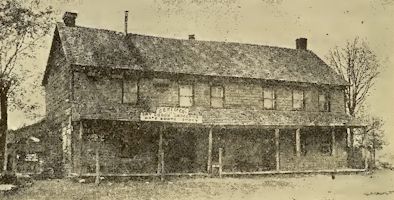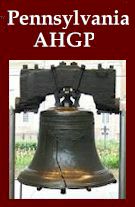Pennsylvania Taverns
James Flint says: "Several taverns on the road after leaving
Chambersburg are log houses constructed by laying square trees
horizontally and in a quadrangular position in a way similar to
that which house joiners tie up boards to be dried." In speaking
of Fort Loudon, which he says is 13 miles from Chambersburg, and
which has a few houses, only two of them taverns, situated at
the foot of the ridge called Cove Mountain, he says: "The other
tavern was so completely thronged with movers that a multitude
had taken up their lodging in a barn. We were permitted to stop
on condition of all three sleeping in one bed which is said to
be a large and good one. Two-thirds of the bar room floor was
covered with the beds of weary travelers, close side by side,
and the remaining occupied by people engaged in drinking and
noisy conversation. The room in which the supper was served was
too small to admit any large proportion of the company at once.
In consequence we had to await the alternation of supper party
before we got to the table.

Mr. _______ says: "Arrived at 8 o'clock at Loudon at the foot of
the North Mountain, one of the Allegheny Ridges. Here are 17 log
and 20 frame houses. We were not allowed to go to breakfast at
the tavern in the town as one of the proprietors of the coach
had a house at McConnellsville. The tavern at Loudon is
cheerless and dirty. A number of wagoners were breakfasting. I
counted thirty engaged in the transportation of goods to and
from Pittsburgh."
John C. May, on his return trip from Harrisburg, stopped at
Sideling Ridge. He says: "Slept in a house, not a window in the
house. I laid and watched the crack under the door until
daybreak when I arose and called up my friend, Captain Carey. We
took our departure immediately. We break-fasted at Fort
Littleton at Captain Burd's in a really elegant manner on fine
coffee, loaf sugar, venison and shad. From there we crossed the
mountain, slept at Captain Rippey's in handsome style after
supping sumptuously on beef steak and sundry knickknacks."
Dr. Michenaux says: "At Shippensburg, the stage coach stopped at
the house of Col. Rippey, who keeps a good tavern, the sign of
Gen. Washington. He is very obliging to the travelers who use
his house on their way to the western country." He says: "At
Fort Littleton, six miles from Shippensburg, I stopped at a very
good tavern kept by Colonel Burd."
Mr. Cummings says: "I stopped at Raum's a German house near the
middle of the town of Shippensburg and apparently the best
tavern in it. I sit down to a good supper after which the
wagoners spread their blankets and mattresses on the floor and I
retired to bed.'" On his journey from Shippensburg he says: "I
met on the road two wagons with six horses each from Zanesville,
Ohio, going to Philadelphia for goods. They had been a month on
the road."
When the tourists and travelers of the earlier days were
journeying over this road there- was but one house where the
engraving shows a street scene in Orrstown. This house was built
by John Finley along about 1752 and is in use as a tavern today?
It was originally a one story log building known in the tax
lists as a "cabin." When the travelling trade demanded more room
it was enlarged with a log kitchen and later a two story weather
boarded building added and along its entire front was a covered
porch and a wagon yard in the rear. Thomas Wilson, one of the
1794 whiskey boys, kept it as a tavern. James Means used it as
his farm house, George Roupe kept it as tavern, James Kyle used
it as a store and was followed by John Clippinger and about 1833
by J- Orr & Brothers. The east end was used as a tavern by Col.
James B. Orr, Philip Pyle, David Fetter. Abram Stump, William
Gracey, John Kyner followed by William S. Bard and others. The
building on the left of the picture, almost hidden by the trees
is the original one improved and enlarged by raising it to two
stories and "casing" it with brick. But behind the trees, the
brick, the paint and other improvements the house of 1752 is
doing duty as a place of "entertainment for man and beast."
The steadily increasing trade and traffic along the road laid
out by the State in 1786 from Widow Miller's Spring which was at
Mount Rock, Cumberland county to Pittsburgh, gave rise to houses
of entertainment along its route. By 1830 there were between
Shippensburg and Sproats or The Juniata Crossings some thirty
taverns, many of them not over a mile apart doing a good
business. The distance between these points was about sixty
miles portions of which were in the mountains and with the
fifteen taverns in Shippensburg there was an average of a tavern
to every mile of the Three Mountain Road.
The engraving at the head of "Taverns" presents the Tavern at
what is now Pleasant Hall and was made from a recent photograph.
This building was erected a little earlier than 1794 and
continues in daily use as a dwelling and place of business. It
is a type of many of the tavern buildings of that early day and
is a two story frame house weather boarded with a covered porch
its entire length. In 1794 it was occupied by William Davis, an
ancestor of Rev. Dr. Davis, of Wooster, Ohio. In 1823 it was
occupied by George Miller as a private citizen, next by Mr.
Hollinger, followed by Samuel Creamer. About 1828 Samuel Fish
kept it as a Tavern, next came Peter Hoch, then George Boltz,
then David Fetter, Abram Stump, William Nicklas, John Golden,
and about 1849 John Harris who later became a county
commissioner in Cumberland county. It was a lively hostelry
during Mr. Harris' time. He had a large family, three or four
very attractive daughters, a son who was good with a "fiddle",
another a noted fancy dancer, an older boy who was a "horse
jockey" in which his father could give him odds, a bar that was
well supplied with the best kinds of liquors, no hampering or
hungry laws as to Sunday or minors, or anybody that grew thirsty
and a wife noted as a good housekeeper. It was a place for
everybody and they all stopped to enjoy its hospitalities, swap
a yarn or two as well as a horse. From 1853 to 1863 Abram Keefer
kept this tavern and he still occupies it with his wife both of
whom are verging on the nineties. The west end of this building
was used as a "cross roads" store by David Fetter, Barney Fohl,
the late Robert E. Tolbert of Chambersburg, and Philip Foust.
Since 1897 Cyrus Keefer has used this room as a store room and
it gives promise of many years of service and usefulness.
In the preparation of this paper I have consulted several
libraries in Pennsylvania and Ohio, and have gathered in a
convenient form much that relates to this valley, as to its
appearance, its customs, its places of entertainment, of more
than a century ago, and trust it may be of profit to any
interested in those faraway days.
AHGP Pennsylvania

Source: The Kittochtinny Historical Society, 1908-1910, Peoples
Register Print, Chambersburg, PA, 1910
|
![]()

![]()


